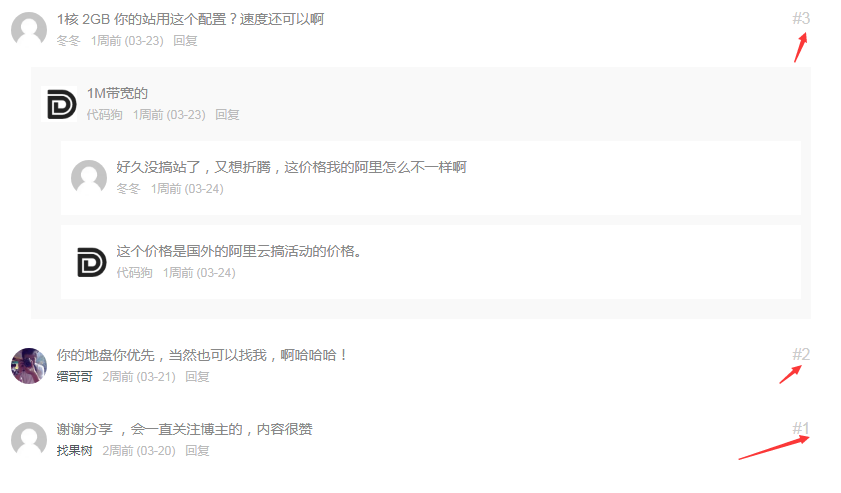前几天有人问我评论列表后面的楼层是怎么实现的,这东西根本不是我写的好吧。有现成的,为什么要自己写?用过大前端DUX主题的站长应该都知道,大前端dux主题的评论列表就有楼层计数功能,拿过来用不就行了?既然有人需要我还是分享下吧。大家也学习下大前端的写法,毕竟人家可是国内的大佬,值得学习。
该文件位于dux主题目录下的modules文件夹中,名字叫做mo_comments_list.php,下面是源码。
复制
/**
* [mo_comments_list description]
* @param [type] $comment [description]
* @param [type] $args [description]
* @param [type] $depth [description]
* @return [type] [description]
*/
function mo_comments_list($comment, $args, $depth) {
$GLOBALS['comment'] = $comment;
global $commentcount, $wpdb, $post;
if(!$commentcount) { //初始化楼层计数器
$page = get_query_var('cpage');//获取当前评论列表页码
$cpp = get_option('comments_per_page');//获取每页评论显示数量
$pcs = get_option('page_comments');//分页开关
$comments = $wpdb->get_results("SELECT * FROM $wpdb->comments WHERE comment_post_ID = $post->ID AND comment_type = '' AND comment_approved = '1' AND !comment_parent");
$cnt = count($comments);//获取主评论总数量
if ( get_option('comment_order') === 'desc' ) { //倒序
if (!$pcs || ceil($cnt / $cpp) == 1 || ($page > 1 && $page == ceil($cnt / $cpp))) {
$commentcount = $cnt + 1;//如果评论只有1页或者是最后一页,初始值为主评论总数
} else {
$commentcount = $cpp * $page + 1;
}
}else{ //顺序
if( !$pcs ){
$commentcount = 0;
}else{
$page = $page-1;
$commentcount = $cpp * $page;
}
}
}
echo '<li '; comment_class(); echo ' id="comment-'.get_comment_ID().'">';
if(!$parent_id = $comment->comment_parent ) {
echo '<span class="comt-f">#'. (get_option('comment_order') === 'desc'?--$commentcount:++$commentcount) .'</span>';
}
echo '<div class="comt-avatar">';
echo _get_the_avatar($user_id=$comment->user_id, $user_email=$comment->comment_author_email);
echo '</div>';
echo '<div class="comt-main" id="div-comment-'.get_comment_ID().'">';
comment_text();
if ($comment->comment_approved == '0'){
echo '<span class="comt-approved">待审核</span>';
}
echo '<div class="comt-meta"><span class="comt-author">'.get_comment_author_link().'</span>';
echo _get_time_ago($comment->comment_date);
if ($comment->comment_approved !== '0'){
$replyText = get_comment_reply_link( array_merge( $args, array('add_below' => 'div-comment', 'depth' => $depth, 'max_depth' => $args['max_depth'] ) ) );
// echo str_replace(' href', ' href="javascript:;" data-href', $replyText );
if( strstr($replyText, 'reply-login') ){
echo preg_replace('# class="[\s\S]*?" href="[\s\S]*?"#', ' class="signin-loader" href="javascript:;"', $replyText );
}else{
echo preg_replace('# href=[\s\S]*? onclick=#', ' href="javascript:;" onclick=', $replyText );
}
}
echo '</div>';
echo '</div>';
}使用方法
方法一
像dux一样,在主题目录下建立modules文件夹,然后将上面的代码保存在该文件夹中,再利用如下代码加载到WordPress中。
复制
function _moloader($name = '', $apply = true) {
if (!function_exists($name)) {
include get_stylesheet_directory() . '/modules/' . $name . '.php';
}
if ($apply && function_exists($name)) {
$name();
}
}加载方式多种多样,直接使用include引用也是可以的。
然后通过_moloader(‘mo_comments_list’, false);来加载上面的代码,最后就是使用了。WordPress提供了评论列表加载方法wp_list_comments函数,该函数可以携带回调函数callback。
复制
wp_list_comments('type=comment&callback=mo_comments_list');上述代码的意思是取出评论数据,并交给回调函数mo_comments_list来处理,mo_comments_list就是上面我们的楼层计数方法,其中包含了输出评论的内容。
方法二
直接将上面的代码写在functions.php文件中,返回在文章页适当位置使用下面代码来调用。
复制
wp_list_comments('type=comment&callback=mo_comments_list');是不是觉得方法二简单很多呢?确实如此,只要你不嫌弃你的functions文件太大,随便你咯。






评论 (1)